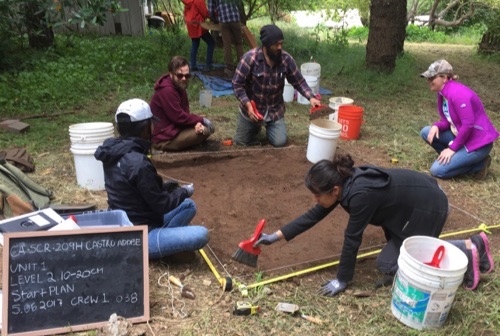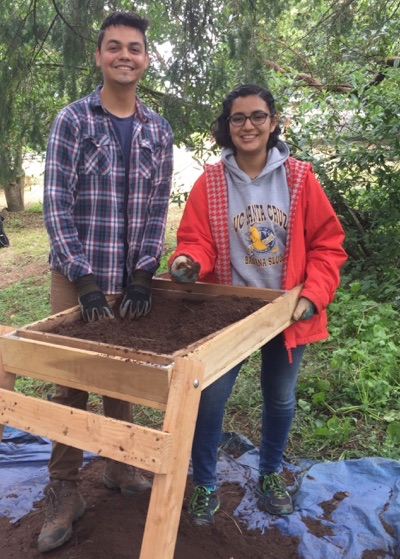On a recent overcast Saturday morning, small clusters of students huddled around plots of exposed earth at Castro Adobe State Historic Park, carefully scraping away dirt in a meticulous search for clues to life on the hacienda more than 150 years ago.
The centerpiece of the park is a two-story adobe that has undergone years of renovation. But before the building can be opened to the public, park officials need to complete an archaeological assessment of the grounds to identify areas for protection.
In a unique partnership, UC Santa Cruz is collaborating with California State Parks, Friends of Santa Cruz State Parks, and a private environmental consulting firm to get students in the field to help. In the process, students gain valuable hands-on experience in archaeology, and the artifacts they uncover help answer important scientific and cultural questions.
"There's a lot of hidden history on this land," said undergraduate Janeth Montenegro, a third-year student majoring in anthropology and philosophy. "Who lived here? What did they do, what did they eat?" Sifting through dirt excavated by her classmates, Montenegro said she hadn't known what to expect when she signed up for the class. Interviewing stakeholders had piqued her interest in ethnographic work, and getting her hands in the dirt exposed her to the reality of archaeology. "So far it's interesting. I like it."
The Castro Adobe is the only remaining building of the Rancho era in the Pajaro Valley—and the only two-story adobe in Santa Cruz County; the Friends of Santa Cruz State Parks undertook the restoration in order to preserve it and make it available for the public.
"It's a great collaboration," said Jessica Kusz, historic preservation project manager for the Friends group. "We're building a state historic park, and the students are becoming part of that. They are helping us define the site, and their work will guide us as we decide where to place trails and interpretive materials."
Sarah Peelo, a UC Santa Cruz alumna (Ph.D., anthropology, 2009) who is teaching the field class, called the partnership "a community archaeology project in the truest sense." Her firm, Albion Environmental, assessed the adobe structure last year, with student volunteers pitching in on their own time. When it came time to evaluate the grounds surrounding the building, Peelo and the Anthropology Department saw the opportunity to collaborate with State Parks and the Friends group.
Peelo described the site as "super rich," explaining that ground-penetrating radar directed the student crews to areas of interest, including the remains of a building foundation, another structure, and multiple refuse pits.
"One of the big questions we're trying to answer this season is 'How were they using this landscape beyond the adobe building?'" said Peelo. "It's bigger than the architectural infrastructure. How were they living on the landscape, how were they getting what they needed?"
Archaeological analysis reveals clues to diet, trade, and interactions with other regions and cultural systems. "The Castro family lived through the Spanish Mission era and into the American period with the Gold Rush. How is this different from the missions, pueblos, and presidios?," asked Peelo.
Crouched over a shallow dirt pit staked out with string, several students were getting a feel for the tedious nature of excavation.
Each layer of dirt is carefully removed, bucket by bucket, then sifted through a fine-mesh screen.
"We might not find much for the first two or three levels," said Alec Apodaca, a senior anthropology major whose past field experience qualified him as a "crew chief." There's a lot more to archaeology than digging, he added, noting the detailed recordkeeping and descriptions of soils, vegetation, and topography, as well as survey work and interviewing of stakeholders that are part of the Castro Adobe project.
Eighteen students enrolled in the class, including Adelisa Coronado, a junior who is majoring in art history with a minor in visual culture. "I thought it would be cool to try out what I've learned about in the classroom," she said.
Steve Cheatham Marvelli had read a lot about the site and the Mission era but was somewhat underwhelmed by the artifacts the team was uncovering. "All we're finding is pieces of wood, but it's fun to get in the dirt," he said. "It's fun to think we might find something."
Excavation doesn't appeal to everyone, said J. Cameron Monroe, associate professor of anthropology who developed the field-course model.
"Archaeology is a hands-on field, and you've got to get out and collect data to understand it," he said. "Students either get hooked or decide they don't want to do archaeology anymore."
Field experience makes graduates infinitely more marketable, and it's key to diversifying the field, as well, said Monroe. "Field schools are potential roadblocks to attracting diverse participants, because they typically take place over the summer and cost $4,000 or more in tuition and fees," he said. "With travel and lost wages, it's a gateway that closes off opportunity for students from low- and middle-income families."
A few years ago, Monroe and Anthropology Professor Diane Gifford-Gonzalez set out to offer a local field course during the school year to provide a low-cost alternative. "Field experience is absolutely key to getting a job after graduation or graduate school," said Monroe. "This class is a cost-effective, affordable pathway to getting a job after school. It's a very popular component of the anthropology major."
The emphasis is on learning how to excavate and analyze artifacts, not on removing massive amounts of material. The trend in California archaeology is to make sure everything that's removed gets looked at—rather than warehoused in boxes, unstudied, for decades.
"California has a curation crisis, so we are leaving a lot of material in place," said Monroe. "We are trying to do ethical and responsible archaeology."
This type of work, called cultural resource management, is the fastest-growing area of archaeology in North America, said Monroe. It's a mandatory component of development projects from government roads to cell-tower construction.
Before the end of the quarter, students will have analyzed each artifact and prepared full reports for the state archives. "Students only get the full value of the experience if they go through the process of data entry and analysis, too," said Monroe. "Students come out of our program knowing how to do things. It's not just theoretical."
####
Students will give tours, host interactive exhibits, and discuss their work during Public Archaeology Day at Castro Adobe State Park from 10 a.m. to 2 p.m. on June 3. There will be activities for kids of all ages and a talk about careers in science. Tacos by Taquitos Gabriel will be available for purchase.
Hands-on learning is the name of the game in archaeology
Partnership with California State Parks and Friends group supports restoration of historic rancho hacienda; visitors welcome on Public Archaeology Day June 3




